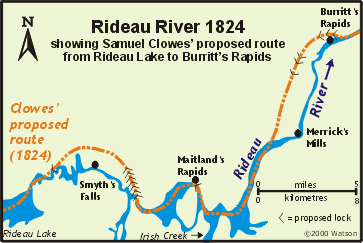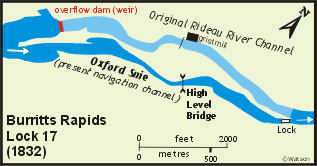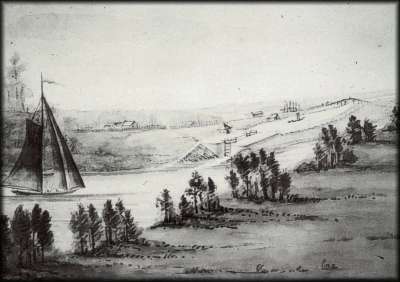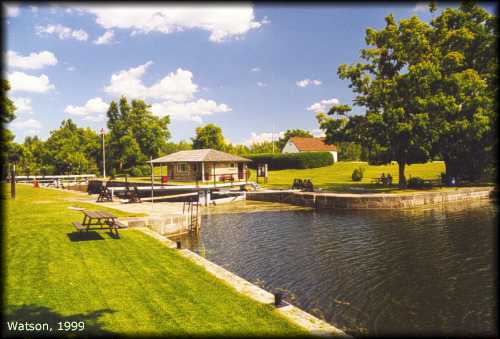Burritts Rapids Lock 17
| location map | lockstation information |
The Setting
Between Burritts and Nicholsons there were several rapids, Burritt's Rapids, Suter's Rapids, Docherty's Ripple, and Cox's Rapids. The banks of the river in this area were quite low. From the head of Burritt’s Rapids, on the east side of the river, Oxford Snie ( a dry flood channel) extended downstream for a mile and half (2.4 kilometres).
The rapids were named after Colonel Stephen Burritt, who had settled here in 1793.
The Plan
 The plan put forward by Samuel Clowes in his 1824 report was to bypass the entire section of the Rideau River between Burritt’s Rapids and Merrick’s Mills with a canal cut on the west side of the Rideau River. Six locks were proposed at the Burritts Rapids end to lift the canal the required elevation (about 55 feet – 17 m). The canal would return to the Rideau River above Merrick’s Mills where a settler named McCrea was located. The plan put forward by Samuel Clowes in his 1824 report was to bypass the entire section of the Rideau River between Burritt’s Rapids and Merrick’s Mills with a canal cut on the west side of the Rideau River. Six locks were proposed at the Burritts Rapids end to lift the canal the required elevation (about 55 feet – 17 m). The canal would return to the Rideau River above Merrick’s Mills where a settler named McCrea was located.
By planned to use his slackwater technique, staying in the channel of the Rideau and flooding the rapids. However since the banks of the river were too low to flood Burritt's Rapids, By had to use the more standard canal building technique of bypassing the rapids. He planned to make use of the dry flood channel, the Oxford Snie, to place his lock and canal. An excerpt from the canal contract reads; "The River is to be raised at this place by a Dam of 10 feet high and 240 feet long or thereabouts with wing walls extending into the banks on each side. A lock of 10 feet lift to be constructed at the lower end of the natural ravine called "Oxford Snie" this is to be made and constructed according to the other locks on the Rideau Canal." The dam was to be placed at the head of the rapids, to raise the water and force it into Oxford Snie.
Building the Locks
The contract for Burritt's Rapids was awarded to Philemon Wright and Sons. Philemon Wright wasn't involved, it was his sons Ruggles and Tiberius who did the Rideau contracts.
 Work at this site proceeded smoothly. To make the snie into a navigation channel, some blasting of the bedrock had to be done, and embankments at the lower end of the snie had to be raised. After excavating the snie in the area of the lock, it was determined that the bedrock was not strong enough and that a floor would have to be put in the lock. To quote By, the floor was needed because, "the rush of Water from the Sluices … would otherwise have worn the bottom of the Lock away, and in time, have undermined the Breast Work and Chamber Walls .." The choices for a floor were an inverted masonry arch or a wooden floor. By opted for the cheaper wooden floor, noting, as he had at several other lockstations, that wood kept underwater was as durable as stone, and was a much cheaper solution. The single lock had a lift of 10 feet (3.0 m). Work at this site proceeded smoothly. To make the snie into a navigation channel, some blasting of the bedrock had to be done, and embankments at the lower end of the snie had to be raised. After excavating the snie in the area of the lock, it was determined that the bedrock was not strong enough and that a floor would have to be put in the lock. To quote By, the floor was needed because, "the rush of Water from the Sluices … would otherwise have worn the bottom of the Lock away, and in time, have undermined the Breast Work and Chamber Walls .." The choices for a floor were an inverted masonry arch or a wooden floor. By opted for the cheaper wooden floor, noting, as he had at several other lockstations, that wood kept underwater was as durable as stone, and was a much cheaper solution. The single lock had a lift of 10 feet (3.0 m).
After his experiences at the other locks, By felt that a waste weir would likely be required at Burritts Rapids. However, an examination of the bedrock showed it to be solid and, "having since that period ascertained that the Rock at that place is of a durable nature, I have returned to the Original Plan." In fact the original plan was somewhat altered, as a straight, timber frame dam, with stone abutments, was substituted for a stone arch dam. Pine stop logs at the top of the dam regulated the height of the water.
The completed works created the topography we see today. An island was formed between the now flooded Oxford Snie (the present day Rideau Canal navigation channel) and the original channel of the Rideau, now with much less water as a result of the dam placed across it near the head of the new island.
A high level bridge, with a clearance of 28 feet (8.5 m), was constructed over the canal, just a bit upstream from where the swing bridge is located today.
 |
Burritt's Rapids; ca. 1840s
John Burrows, watercolour, Archives of Ontario
This painting shows the lock, leading to the artificial channel on the left, with the high level bridge over the channel seen in the distance. The original channel of the Rideau River is below the embankment on the right. |
Through the Years
The lock here didn't need much more than routine maintenance as a result of age. The dam took the brunt of flood damage and was destroyed by ice in 1847. It was replaced with a timber crib dam incorporating a weir and an ice breaking crib was placed upstream of the dam. The weir and dam were repaired several more times and in 1930 the weir was re-built in concrete and in 1951 the dam was also rebuilt in concrete.
In 1909-1910 the south lock wall and both upper wing walls of the lock were rebuilt.
In 1832, work was started on a blockhouse, similar to those being built at the Narrows, Newboro and Kingston Mills. However work was stopped with only the stone walls erected. In 1836 a roof was constructed over the walls to make it into a one-storey house. In 1914-15 a two-storey frame house was built on the foundation of the original stone house. It was eventually torn down in 1969 to make way for the present lockstation office.
The first townsite was laid out in 1830 and a post office, with the name "Burritt's Rapids" was established in 1839. In the 20th century, the name was changed to "Burritts Rapids" and today, both the community and lockstation are known by that name.
 |
Burritts Rapids Lockstation
photo by: Ken Watson, 1999
It’s difficult to see today that the left (north) side is an artificial embankment. Burritts Rapids typifies the tranquil beauty of a Rideau lockstation. |
The Lockmasters to 2000
By recommended William Mitchell, a corporal in the 15th Company of Royal Sappers and Miners, but it appears that Mitchell may have taken a position as lockmaster at Hogs Back, rather than here at Burritts Rapids. In 1835, a man by the name of White was lockmaster. He resigned in 1836 and was replaced by John Newman, formerly with the Royal Sappers and Miners. In November 1847, he was transferred to Nicholsons and was replaced by George Shepherd (from Bytown). Shepherd, a former colour sergeant with the Royal Sappers and Miners, served here until he retired in 1880. His replacement was James Todd of Kemptville who retired in 1905 and was replaced by a former lock labourer at this station, John Merrifield. Merrifield was dismissed in 1912, likely on patronage grounds and he was replaced by Robert H. Ferguson of Burritts Rapids who served until 1944. Fred Dawe, the last lockmaster to live in the lockmaster's house (which was demolished in 1967) served from 1945 to 1960. He was followed by Ed Moore from 1960 to 1967; Claude Action from 1967 to 1973; Stan Irvine from 1974 to 1976; John Cassidy in 1977; Walter Bown from 1978 to 1987 (Bown was on disability from 1985 to 1987 and there were a number of acting lockmasters; Jack Arnold, Steve McVeety, Ken Dale and Kerry McGonegal); and Jack Arnold from 1988 to 2000.
|